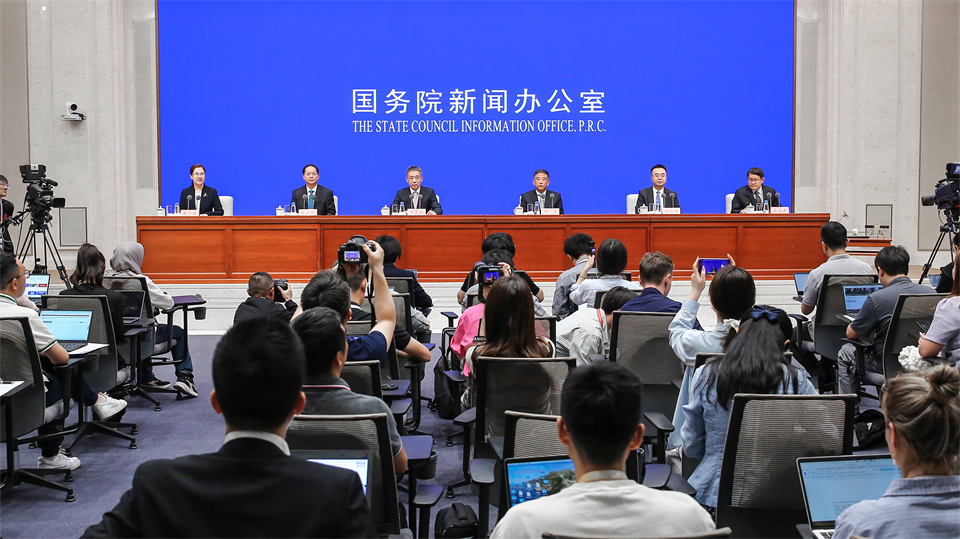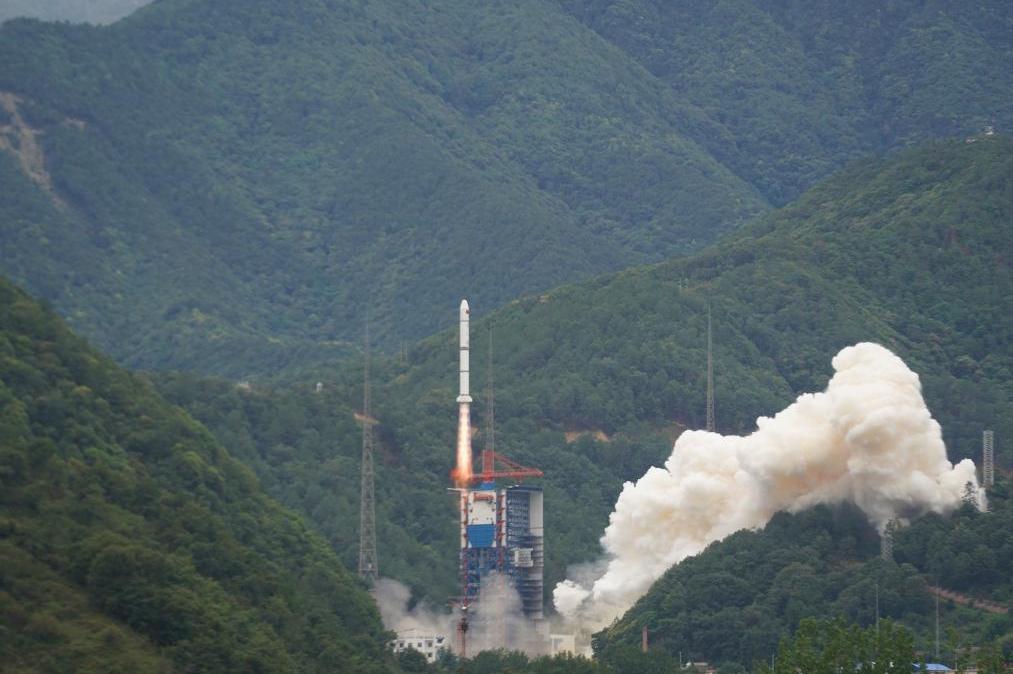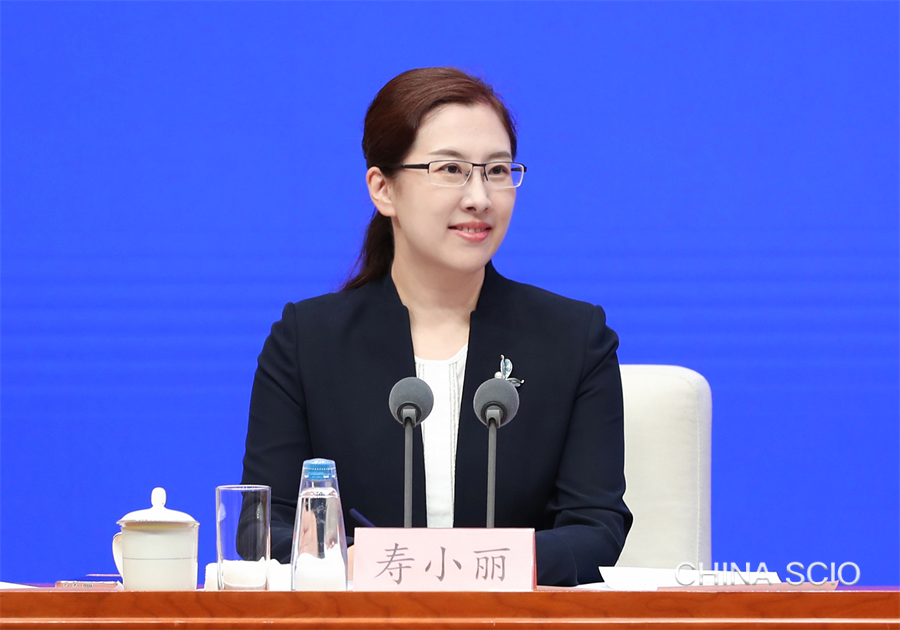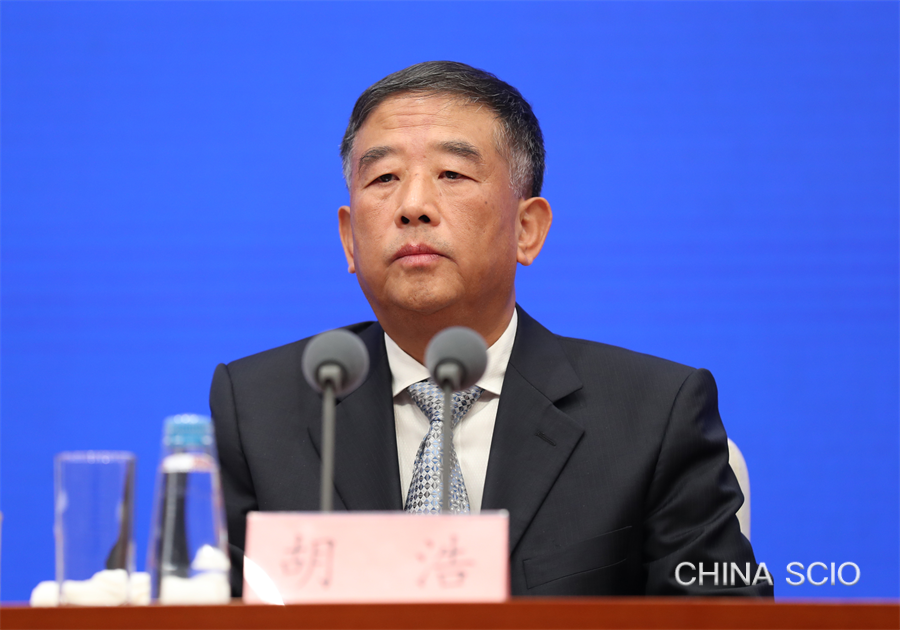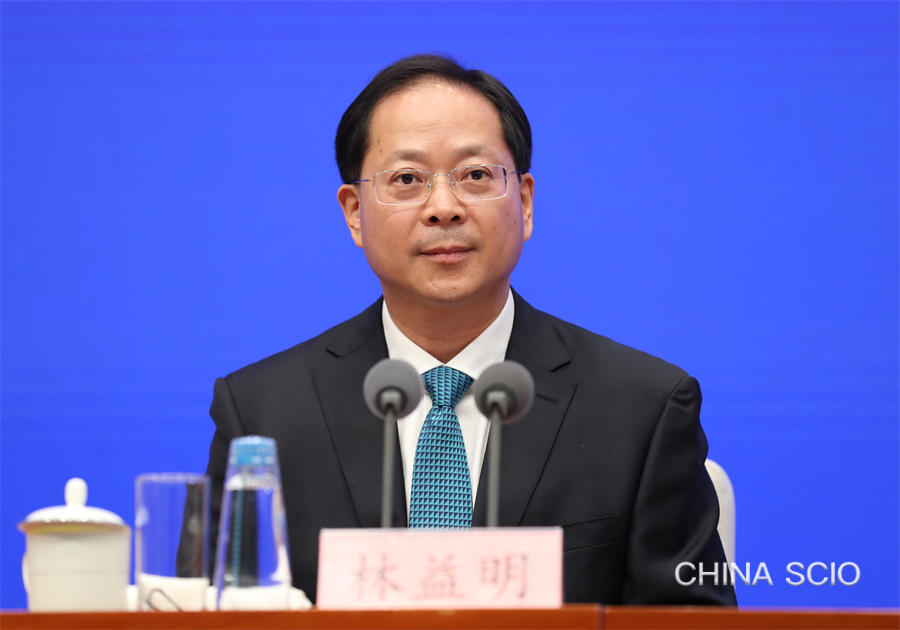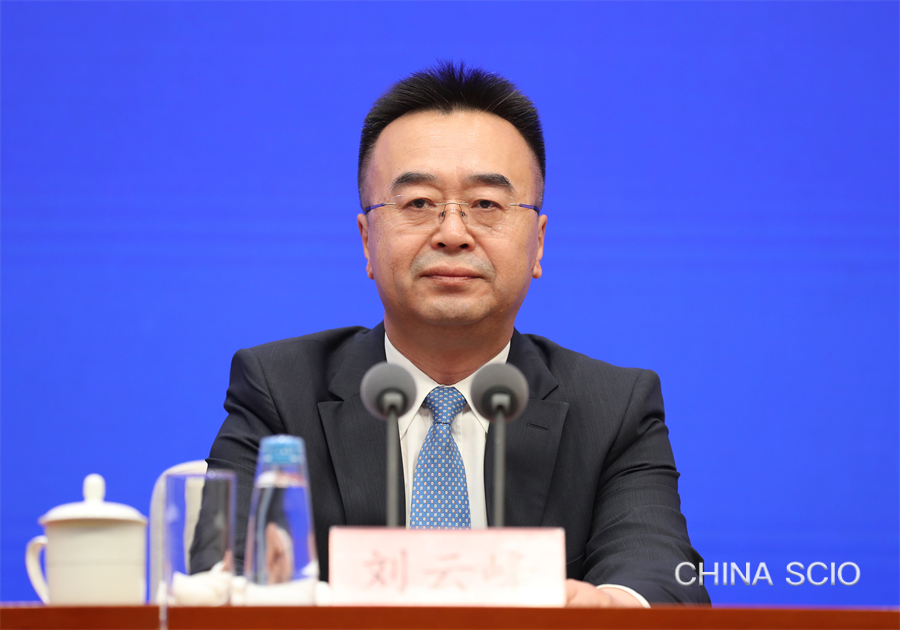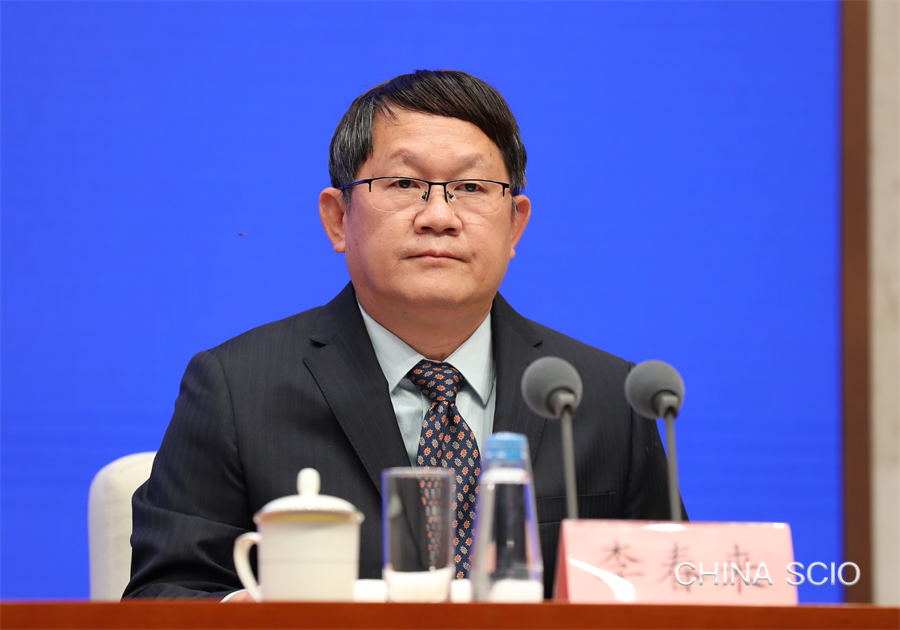Read in Chinese
Speakers:
Mr. Bian Zhigang, vice administrator of the China National Space Administration (CNSA)
Mr. Hu Hao, chief designer of the Chang'e-6 mission
Mr. Lin Yiming, vice president of China Aerospace Science and Technology Corporation
Mr. Liu Yunfeng, a person in charge of the Department of International Cooperation at the CNSA
Mr. Li Chunlai, deputy chief designer of the Chang'e-6 mission and researcher of the National Astronomical Observatories of the Chinese Academy of Sciences
Chairperson:
Ms. Shou Xiaoli, director general of the Press Bureau of the State Council Information Office (SCIO) and spokesperson of the SCIO
Date:
June 27, 2024
Shou Xiaoli:
Good afternoon, everyone. Welcome to this press conference held by the State Council Information Office (SCIO). The Chang'e-6 mission has been a complete success. Today, we have invited Mr. Bian Zhigang, vice administrator of the China National Space Administration (CNSA), to brief you on the mission's developments and answer your questions. Also present today are Mr. Hu Hao, chief designer of the Chang'e-6 mission; Mr. Lin Yiming, vice president of China Aerospace Science and Technology Corporation; Mr. Liu Yunfeng, a person in charge of the Department of International Cooperation at the CNSA; and Mr. Li Chunlai, deputy chief designer of the Chang'e-6 mission and researcher at the National Astronomical Observatories of the Chinese Academy of Sciences.
Now, I'll give Mr. Bian the floor for his introduction.
Bian Zhigang:
Thank you, Ms. Shou. Hello, everyone. I would like to express my gratitude for your interest in and support for and coverage of the Chang'e-6 mission.
Here at the venue, we have models of the Chang'e-6 lunar probe and the Queqiao-2 relay satellite on display. At 2:07 p.m. (Beijing Time) on June 25, the returner of the Chang'e-6 lunar probe landed precisely in its designated area in Siziwang Banner, north China's Inner Mongolia autonomous region, bringing back samples collected from the moon's far side for the first time in human history. General Secretary Xi Jinping extended congratulations on the complete success of the Chang'e-6 mission, noting that this mission marks another landmark achievement in China's endeavor to build a strong country in space as well as in science and technology. All those who participated in the mission have been greatly inspired.
The fourth phase of the lunar exploration program is a major space project personally approved by General Secretary Xi Jinping. It fully demonstrates the high level of regard and care for the country's space industry by the Communist Party of China (CPC) Central Committee with Comrade Xi Jinping at its core, as well as the unique strengths of the new system for mobilizing resources nationwide. As the third plenary session of the 20th CPC Central Committee approaches, the Chang'e-6 mission's achievement of the world's first lunar far-side sample return has exhilarated the entire nation and captured global attention. Over the past three months, we, together with the people across the country, have closely followed and eagerly anticipated every step of the Chang'e-6 mission. On March 20, the relay satellite Queqiao-2 was launched to provide Earth-moon communications services. On May 3, a Long March-5 rocket was launched on schedule, successfully sending the Chang'e-6 probe into its predetermined orbit. Over 53 days, Chang'e-6 underwent 11 challenging stages. These included Earth-moon transfer , near-moon braking, and the separation of the lander-ascender combination from the orbiter-returner combination. It then achieved a smooth lunar landing, used a drill to collect subsurface samples, and grabbed surface samples with a robotic arm. The mission continued with lifting off from the lunar surface, rendezvous and docking between the ascender and the orbiter-returner combination, and the transfer of samples. This was followed by lunar orbiting, moon-Earth transfer, and finally, re-entry and recovery. Finally, the Chang'e-6 probe successfully returned to Earth.
This was a journey of exploration. The geological structure, material composition, and early cosmic environment of the far side of the moon are shrouded in mystery. The Chang'e-6 probe landed at the edge of an impact crater known as the Apollo Basin, located in the northeast of the South Pole-Aitken (SPA) Basin on the far side of the moon. The crater is the largest, deepest, and oldest known impact crater on the moon. Scientists will study the subsurface samples collected with a drill and the surface samples grabbed with a robotic arm, hoping to unravel significant scientific mysteries about the evolution of the moon and the solar system.
This was a journey of innovation. The Chang'e-6 mission was the most technically advanced lunar exploration endeavor in China's space history, achieving three major technological breakthroughs and one world first. Specifically, it mastered the technologies of lunar retrograde orbit design and control, intelligent sampling as well as takeoff and ascent from the far side of the moon. Additionally, it successfully accomplished the world’s first automatic sampling and return from the far side of the moon, setting another world record for China's space endeavors. Additionally, the new basalt fiber material and intelligent mobile camera technology, were used to unfurl a Chinese national flag on the far side of the moon. These advancements have broad applications for national economic growth and the public's well-being, contributing to a better quality of life.
This is also a journey of cooperation. This mission involved cooperation with the European Space Agency (ESA), France, Italy, and Pakistan in operating four payloads, obtaining valuable firsthand scientific data. Additionally, there was collaboration in the field of telemetry, tracking, and control. Space agencies from several countries, diplomats stationed in China and officials from international organizations were invited to observe the launch. After the success of the mission, heads of those organizations, as well as foreign counterparts and friends, sent us congratulations and spoke of their interest in deepening cooperation with China. I would like to express my gratitude on behalf of the CNSA. We also encourage domestic and foreign scientists to jointly conduct scientific research on lunar samples and data, and strive to obtain more original outcomes.
It is particularly noteworthy that this year marks the 20th anniversary of the CPC Central Committee's decision to implement the lunar exploration program. Over the past 20 years, those involved in the program have strengthened their responsibilities to the mission, kept moving forward until our goals are met, and advanced steadily step by step, leading to successive victories and continually turning the Chinese nation's dream of embracing the moon into reality. The program has brought together thousands of research units and tens of thousands of scientific and technological workers across the country, fostering and refining the spirit of lunar exploration. It has cultivated many outstanding scientific, technical and management talents, formed a successful model for the implementation of major scientific and technological projects, built up China's core capabilities in deep-space exploration, and forged a high-quality and cost-effective path for lunar exploration. Each mission, after achieving its set goals, has conducted extended experiments, laying a more solid foundation for subsequent project tasks. For example, in the field of scientific discovery, scientists from around the world have published over 1,900 research papers based on China's lunar exploration data. Chinese scientists discovered a new mineral using lunar samples collected during the Chang'e-5 mission and named it Changesite-(Y). This is the sixth mineral found on the moon by mankind. Their research also proved that magmatic activities existed on the moon 1.96 billion years ago, extending the "life" of lunar volcanism 1 billion years longer than previously known. The entry of lunar samples into the "Chang'e Era" has greatly enriched humanity's understanding of the moon and the universe.
Ladies and gentlemen, deep space is boundless and infinite, while humanity's quest for knowledge is limitless. The follow-up Chang'e-7 and Chang'e-8, and the planetary exploration missions Tianwen-2 and Tianwen-3, are progressing as planned. The CNSA will further conduct various forms of international exchanges and cooperation in the aerospace sector based on equality, mutual benefits, peaceful utilization and inclusive development. We look forward to joining hands with more international colleagues to make new contributions to expanding human understanding, improving human welfare and promoting the construction of a global community of shared future for mankind in outer space.
Thank you. Next, my colleagues and I will take your questions.
_ueditor_page_break_tag_
Shou Xiaoli:
Thank you, Mr. Bian. The floor is now open for questions. Please state the name of the media organization you work for before asking your questions.
China Daily:
Yesterday afternoon, the reentry capsule of the Chang'e-6 lunar probe was opened in Beijing. The public is very interested to know, how many grams of lunar samples were retrieved this time? In addition, what challenges and difficulties did you encounter during this mission to the moon's far side? And what innovations were made during the Chang'e-6 mission?
Bian Zhigang:
I'd like to invite Mr. Hu to answer your questions.
Hu Hao:
Just like the Chang'e-5 sampling mission, our plan was to bring back 2 kilograms of lunar soil during the Chang'e-6 mission. The container was designed to hold exactly 2 kilograms, and cannot hold any more. We will have to wait until tomorrow to reveal whether we have achieved this goal, but we are confident that there will be surprises.
Originally as a backup for Chang'e-5, the Chang'e-6 program was intended to fulfill a new mission: working on the far side of the moon. Speaking of challenges faced by the program, I believe they can be summarized in the following aspects: First, were in terms of quality and reliability. Space missions are extremely complex. As a backup, it had been a long time since the Chang'e-6 spacecraft was produced. All products have a lifespan as soon as they are produced, and the lifespan of Chang'e-6 determined how the mission would be completed. How do we handle, replenish and replace these products with longer production times during the implementation? All these were significant challenges.
To successfully complete the Chang'e-6 probe mission, we made some replacements based on spare components for the Chang'e-5 spacecraft. We must ensure that all products sent into space are safe and reliable. The same is true for ground-based products. As the aerospace sector is a large system, only by collaborating between space and ground systems can we accomplish the mission. The quality of ground-based equipment affects the reliability of the entire system. Much of the equipment was manufactured during the Chang'e-1 mission, so before the launch of Chang'e-6, we thoroughly reviewed the quality and reliability of the spacecraft and ground equipment to ensure that the entire system was more robust, healthier and more reliable. This was our first challenge. To complete any mission, we must have a healthy body, so we always follow the principles of putting the condition of the probe and rocket first.
Second, the challenges brought to us by changes in technological conditions. To land and collect samples on the far side of the moon, we needed to make many compatibility changes and also some adjustments to adapt to the conditions on the moon's far side. As we know, direct communication is not possible with the moon's far side, which required us to add a relay satellite. The probe needed to be adapted to this relay satellite's requirements, which then brought us many challenges. We paid great attention to the challenges brought by the changes in technological conditions. Through thorough verification and full preparation, we ensured these changes in conditions could respond to the requirements of the lunar environment and the entire system.
Third, the challenges in terms of planning. We started the Chang'e-6 mission in August 2022, and launched the lunar probe on May 3, 2024, giving us only around a year and a half for preparation. This was a tense part of the whole project. Moreover, we added international payloads and a relay satellite. We needed to develop the relay satellite from scratch, and our research team overcame multiple difficulties during this short period to carry out numerous experiments and extensive verification work. The current relay satellite was designed not only for the Chang'e-6 mission, but also for subsequent missions. Therefore, we needed to carry out continuous cutting-edge research to ensure it met the needs of both the Chang'e-6 mission and subsequent development. Therefore, we carried out a lot of work in terms of research and development in the past more than one year, which was quite challenging.
Fourth, challenges in terms of international payload cooperation. We promised to carry 10 kilograms of international payloads on both the lander and the orbiter and we fulfilled our promise. We did a good job in carrying the payloads, which were all related to research projects. During this period of more than one year, we needed to work with international teams to jointly complete the mission, which was very challenging. We speak different languages, have different working habits, and follow different standards on research and development programs, therefore, we needed to accommodate each other as we carried out a large number of experiments. The facts show that we successfully fulfilled our mission, or in other words, we successfully addressed these challenges. These challenges are invaluable and we will draw on these experiences to perform more complicated tasks in the future. Thank you.
_ueditor_page_break_tag_
Xinhua News Agency:
The landform is very complex on the moon's far side, where communication is limited. What advanced technologies or strategies were used to ensure the lander's safe landing and effective sampling during the 53-day intricate mission to explore the moon's far side? Also, how did the research team ensure the high reliability of the probe during the research and development process? Thank you.
Bian Zhigang:
This really was a huge challenge. I would like to invite Mr. Lin to answer your questions.
Lin Yiming:
Thank you for your questions. Our mission was to enable the Chang'e-6 lunar probe to collect samples from the moon's far side and bring them back. At the beginning of the research and development, we were already aware of the great difficulties, challenges and risks we would face, such as the complex landform on the moon's far side and high requirements for the timing of the sampling. When the probe lifted off from the moon's far side, the ground could not provide support, hence the probe's take-off mainly depended on our monitoring and control of orbit-related calculations. To back up this work, our team made breakthroughs in the design and control of the lunar retrograde orbit, intelligent sampling on the moon's far side, autonomous lift-off on the moon's far side, and other relevant key technologies, completing reliable and safe sampling work and bringing the samples back.
As for how the mission's success was ensured, Mr. Hu has already mentioned related measures. I would like to add a few more.
First, we designed the probe based on system engineering technologies, focusing on the probe's comprehensive integration and optimized design. When selecting the flight orbit, we used our experience from previous missions and took into account the relationship between the Chang'e-6 and Chang'e-5 probes, as Chang'e-6 was originally designed as a backup for Chang'e-5. One of the considerations was on the configuration and layout. Moreover, we overcame various constraints in terms of resources, such as the area for sampling, illumination on the moon's far side, as well as measurement and control conditions, and designed a retrograde orbital flight plan, providing an optimal and highly efficient design plan for the entire system.
Second, emphasis was placed on risk recognition and control throughout the research and development process to ensure the lunar probe's high quality and reliability. Based on the characteristics of the Chang'e-6 mission, we implemented thorough measures for risk recognition and control in both technology and management, utilizing specialized methods for aerospace products. Carrying forward China's space industry's spirit and fine traditions, we adhered to the "zero-defect" management philosophy and maintained a rigorous and meticulous work style. In line with aerospace quality processes, we addressed every doubt, potential issue, or problem to achieve our goal of doing things right the first time. As you know, there are more than one thousand actions during the flight process, and we executed each one precisely.
Third, significant work was done to improve quality management from good to excellent to accomplish the mission. We established a quality management system for China's aerospace science and technology that is scientifically structured, process-optimized, efficient, collaborative, and continuously improving. By managing the quality of all personnel, elements, processes, and data and carrying out a series of activities that included organizational oversight, independent evaluations, credibility building, and verification, major projects, represented by the lunar exploration program, have been successfully completed with high quality and efficiency.
The complete success of the Chang'e-6 mission is a historic achievement made under the strong leadership, close attention, and dedicated care of the CPC Central Committee with Comrade Xi Jinping at its core. It is also a remarkable fruit achieved by leveraging the strengths of the new system for mobilizing resources nationwide to realize greater self-reliance and strength in science and technology. Looking forward, we will bear in mind our mission of building up China’s strength in aerospace, promote the spirit of China's space industry and lunar exploration program, and continuously implement the country's major space projects, including deep space exploration. This will enable us to contribute more to boosting China’s aerospace strength and advancing national rejuvenation. Thank you.
_ueditor_page_break_tag_
AFP:
U.S. laws prohibit space cooperation with China. What are your comments and views on this? Will American scientists participate in the research of the new lunar samples collected by Chang'e-6? Thank you.
Bian Zhigang:
Thank you for your questions. China has always maintained an open mind regarding aerospace exchanges and cooperation with the U.S. We have previously established working groups for space cooperation in earth and space sciences with the U.S., and we have also once established a civil space dialogue mechanism with the U.S. government. At the request of the U.S., we also created an exchange mechanism for orbital data of Mars rovers, so that the two countries could jointly assess collision risks and ensure the smooth and sustained progress of both sides' Mars exploration programs. However, U.S. domestic laws, such as the Wolf Amendment, have become obstacles impeding aerospace cooperation between the two countries.
Over six decades of space endeavors, China has made great achievements in this area, and all these accomplishments are the result of the hard work and wisdom of the Chinese people. While the Wolf Amendment has hindered normal Sino-U.S. aerospace exchanges, it cannot impede the rapid progress of China's space development.
As for your question, I believe that U.S. scientists are willing to participate in the study of the new lunar samples. If the U.S. genuinely wants to engage in normal space exchanges with China, it should take concrete measures to remove the obstacles.
In the future, China will advance its space plan at its own pace and for peaceful purposes, while maintaining an open-minded and inclusive attitude to embrace equal and mutually beneficial cooperation. Thank you.
_ueditor_page_break_tag_
Cover News:
We know that the previous 10 lunar sampling missions were conducted on the moon's near side. Why did the Chang'e-6 probe choose to collect samples from the South Pole-Aitken Basin on the far side of the moon this time? How does collecting soil from the far side differ from collecting it from the near side? What potential scientific advancements could this bring to our research? Thank you.
Li Chunlai:
Thank you for your questions. The decision to land Chang'e-6 in the South Pole-Aitken Basin on the far side of the moon was based on a combination of scientific and technological considerations. Technologically, as Mr. Hu mentioned, direct communication with Earth is not possible from the far side of the moon. Therefore, sampling and landing on the far side require overcoming this obstacle by launching a relay satellite to facilitate communication for sampling and landing operations on the far side of the moon. This is an important validation and enhancement of deep space communication technology. Additionally, the far side of the moon has a much more complex terrain and topography compared to the near side. Successfully landing and collecting samples in such an area involve overcoming many difficulties, but it also helps to advance the technological level of lunar exploration missions, laying a foundation for future operations under complex exploration conditions.
In terms of scientific research, the South Pole-Aitken Basin is the largest, deepest and oldest basin discovered on the moon so far. Studying its geological composition, material makeup and evolutionary history can help us understand the primary geological evolution of both the moon and the Earth. To date, all the lunar samples collected by humans from previous 10 trips, including those from the Chang'e-5 mission, have been collected from the moon's near side. Chang'e-6 brought back samples from the far side of the moon for the first time, which will hopefully provide crucial insights into the dichotomy of the moon and help us gain a more complete understanding of its history. Samples from the South Pole-Aitken Basin might include materials from the moon's deep interior or even its mantle, offering valuable data for studying the moon's internal composition. Therefore, landing and sampling on the far side not only represent a significant scientific breakthrough, but also advance lunar exploration technology, highlighting the multifaceted significance of the Chang'e-6 mission.
The samples collected from the far side of the moon, and from the South Pole-Aitken Basin in particular, might exhibit significant differences in terms of mineral chemical composition compared to those from the near side. These differences will soon be revealed. Studying these samples will help reveal the unique geological structures and material compositions of the moon's far side, providing a more comprehensive understanding of the moon's geological evolution history. In other words, with the samples collected previously, we have only understood half of the moon. The Chang'e-6 sampling site is located in a vast impact basin, which may have ejected materials from the depths of the moon. These materials which were ejected during early impacts, are extremely valuable and also difficult to obtain. This offers a great opportunity to understand the internal structure and composition of the moon. The South Pole-Aitken Basin, being a massive impact crater, can provide insights into early impact history and even the early impact processes on Earth, helping us to understand the history of the early evolution and impacts of the solar system, and advancing comparative planetology research. Thank you.
Hu Hao:
I would like to add something. Mr. Li has provided a very professional introduction, so I will offer a "less professional" perspective. During the sampling process, we noticed that the soil from the far side of the moon seems different from that of the near side. The soil from the near side is relatively soft and loose, while the soil from the far side seems different. Therefore, we have high expectations and hope that scientists will make significant new discoveries. Thank you.
_ueditor_page_break_tag_
Television Broadcasts Limited:
This mission took a total of 53 days and marks the first time that humans have collected lunar soil samples from the far side of the moon. What were the most difficult and challenging parts of the entire mission? A team from Hong Kong Polytechnic University (PolyU) participated in the development of the sampling equipment for the Chang'e-6 mission. How did their design help the team overcome these difficulties? Will there be more collaborations of this kind in the future? Thank you.
Hu Hao:
The lunar sample collection received special support from PolyU, as the Surface Sampling and Packing System used in this mission was jointly designed and developed by professor Yung Kai-leung 's team at the university. The process was quite challenging because the school does not traditionally engage in aerospace design and manufacturing. Despite this, they overcame numerous difficulties. The team was outstanding, diligent and meticulous, ensuring that the system was flawless before launch. This was true for both the Chang'e-5 and Chang'e-6 missions. In fact, I believe the Chang'e-6 sampling operation went even more smoothly than Chang'e-5, collecting more samples than anticipated. The results are promising regarding the amount collected. Moreover, we hope that more of our Hong Kong compatriots can get involved. During the initial phase of research, many universities and research institutions in Hong Kong applied for and received lunar samples. We also hope that these participating institutions and schools in Hong Kong will produce excellent results. The outcomes of the Chang'e-6 mission look very promising, and we encourage their enthusiastic participation.
Thank you.
_ueditor_page_break_tag_
Phoenix TV:
We understand that the lunar soil samples collected by Chang'e-6 come with high expectations. What is the research and application mechanism for these samples? Are foreign scientific research teams eligible to apply? Thank you.
Bian Zhigang:
I will invite Mr. Liu Yunfeng, who oversees international cooperation, to answer this question.
Liu Yunfeng:
The acquisition of samples from Chang'e-6 has garnered significant attention. China has been actively promoting international cooperation since the beginning of lunar and deep space exploration. To foster effective joint research and applications in the field of lunar and deep space exploration, and to facilitate the international sharing of scientific achievements, the CNSA has formulated the lunar sample management regulations and the Rules for Management of International Cooperation in Lunar Samples and Scientific Data. These regulations detail the application process for lunar samples research and provide specific information on international cooperation. China welcomes researchers worldwide to apply according to the relevant procedures and share the benefits. Thank you.
_ueditor_page_break_tag_
CGTN:
This year marks the 20th anniversary of China's lunar exploration program. Over the past 20 years, we have made remarkable achievements, from taking photos of the moon to the first landing on the far side of the moon and bringing back lunar samples. Looking ahead, what are China's plans for deep space exploration? What key projects will be prioritized in China's space program? Thank you.
Bian Zhigang:
In the future, China's deep space exploration will focus on two aspects: lunar exploration and planetary exploration. In terms of lunar exploration, following the complete success of the Chang'e-6 mission, we will proceed with the Chang'e-7 and Chang'e-8 missions. The Chang'e 7 mission is mainly to survey resources at the lunar south pole , while Chang'e 8 will conduct technical verification of the in-situ utilization of lunar resources. In the future, we plan to collaborate with international partners to build an International Lunar Research Station (ILRS) , promoting shared use and benefit from our lunar exploration results. In terms of planetary exploration, China has approved four missions to be accomplished within 10-15 years. Among them, the Tianwen -1 Mars mission, which was a complete success in 2021, marked China's advancement beyond lunar exploration. Our future missions will include asteroid exploration, a Mars sample return mission, and the exploration of other planetary systems. These missions aim to advance our understanding of the origin and evolution of the solar system, study the impact of small celestial bodies and solar activity on Earth, and search for signs of extraterrestrial life, among other scientific goals.
Around 2025 , Tianwen-2 will embark on its main mission of asteroid exploration. It will aim at a near-Earth asteroid for companion flight and sample retrieval. The Tianwen-3 Mars mission, set for around 2030, aims to return samples from Mars to Earth. Tianwen -4 is scheduled to explore the Jupiter system by around 2030. Currently, we are intensively working on the key technologies and the detailed implementation plans for both the Tianwen-3 and Tianwen-4 missions. Additionally, we are also deliberating major national science and technology projects, including heavy-lift launch vehicles and reusable space transport systems. In the future, we will also strengthen basic research, accelerate the R&D of key and core technologies, and promote the innovative development of space science, space technology, and space application.
I think we may have several more press conferences here over the next 10 years. Thank you.
_ueditor_page_break_tag_
Beijing Youth Daily:
As we eagerly anticipate the exciting discoveries that the Chang'e-6 lunar probe will bring back, I would like to inquire about the findings from the 1,731 grams of lunar samples retrieved by Chang'e-5 in December 2020. Over the past three and a half years, what progress has been made in researching these lunar samples? Have we uncovered any secrets about the moon? Thank you.
Li Chunlai:
It has been over three years since the Chang'e-5 mission retrieved lunar samples, specifically basalts collected from the near side of the moon. Since then, Chinese scientists have conducted systematic research on these samples and achieved numerous breakthroughs, many of which have been published in major academic journals such as National Science Review, Science Bulletin, Nature and Science. More than 100 high-quality journal articles have been published in this short period, covering topics such as the moon's geology, geochemistry, lunar chronology, space weathering, lunar impact glasses, and the utilization of lunar soil. One of the most significant discoveries is that the basalts retrieved by the Chang'e-5 probe were found to have been formed by volcanic eruptions approximately 2 billion years ago. Distinct from the research results on older samples returned by the Apollo missions, this discovery has extended the known period of lunar volcanism by nearly 1 billion years. In addition, the Chang'e-5 samples have been identified as a new type of basalt, formed from a previously unknown magmatic activity. This discovery fills the gap in lunar sample studies conducted by the United States and the former Soviet Union. Moreover, a special mineral named Changesite-(Y) was also discovered in the Chang'e-5 samples, and other chemical features of these samples indicate that volcanic activity during the moon's geological evolution may have occurred in a unique environment. Chinese scientists have also thoroughly studied the glass materials in the Chang'e-5 lunar regolith samples, detecting a variety of space-weathered hydroxyl radicals and iron nanoparticles. Therefore, the research results have been quite fruitful. Thank you.
Liu Yunfeng:
Allow me to share an additional update. China has initiated the first application and review process for international participants to study Chang'e-5 lunar samples. We will inform the media at the appropriate time once the results are available.
_ueditor_page_break_tag_
China Media Group:
My question for the spokesperson: General Secretary Xi Jinping noted in his congratulatory message on the complete success of the Chang'e-6 mission that over the past 20 years, all those involved in the project have embarked on a path of high-quality and highly effective lunar exploration. How do you define "high-quality" and "highly effective" in the context of lunar exploration? What are the specific examples? Thank you.
Bian Zhigang:
I believe this is evident in every aspect of our work. Our lunar exploration project has been ongoing for 20 years. Over the past two decades, we have faced this momentous project head-on and completed the engineering and scientific tasks beyond the set targets, all within the specified timeframe and budget. I'll leave more details to Mr. Hu.
Hu Hao:
I have been involved in this project for quite some time, so I'll break it down for you. China's lunar exploration project started relatively late, as multiple countries had already launched their projects before us. Around the time of the Chang'e-1 probe, other countries had already conducted more than 100 lunar exploration activities. Therefore, it was a late start for China. However, we made sound plans, drawing upon the experiences of other countries, and made appropriate arrangements in accordance with China's national conditions. We proposed a three-step lunar exploration strategy at that time: "orbiting, landing, and returning." This has advanced the country's overall space exploration technology, nurtured a group of talented individuals, and improved our understanding of the moon. With reasonable costs and a comparatively short period, this project has yielded significant results. Today, the reason why some foreign experts and institutions have taken the initiative to work with us in exploring the moon is our hard work over the past two decades. Our success has ensured our credibility and boosted the confidence of all participants.
In addition, we are also witnessing improvements in technological capacities and their enabling conditions. At the time of the Chang'e-1 probe, we lacked the Chinese Deep Space Network , the measurement techniques related to the re-entry corridor , and the ability to conduct high-speed re-entry and return at escape velocity. However, these challenges have been overcome in the past two decades. China has not only landed on the moon but also reached Mars. Over this period, we have forged a path, developed a skilled team, and achieved numerous accomplishments. Thank you.
_ueditor_page_break_tag_
Nanfang Daily, Nanfang Plus:
The Chang'e-6 spacecraft carried international payloads from France, Italy, the ESA, and Pakistan. Could you provide details on these collaborations? What additional international cooperation projects are planned for future lunar and deep-space exploration missions? Thank you.
Bian Zhigang:
As you mentioned earlier, China is committed to collaborating fully with global peers in aerospace exploration. I'll pass the floor to Mr. Liu Yunfeng for further details.
Liu Yunfeng:
Thank you for your question. The situation of the international payloads on Chang'e-6 has been of great interest to everyone. Mr. Bian has already introduced that there were a total of four international payloads. I will introduce them one by one. On May 8, the cube satellite from Pakistan successfully separated from the Chang'e-6 probe after the near-moon braking maneuver, captured images of the moon, and transmitted them back, thus successfully completing its mission. On May 10, the CNSA handed over the data from the cube satellite to the Pakistani side. On June 2, after the lander and ascender module landed on the moon, France's lunar radon detector, and the lunar surface negative ion analyzer of the ESA, smoothly carried out scientific explorations. Italy's laser retroreflector is working normally; the radon detector operated on the lunar surface for 32 hours, and the lunar surface negative ion analyzer functioned for 3 hours and 50 minutes. It should be said that the performance of these international payloads has been outstanding.
China has always adhered to the principles of equality and mutual benefit, peaceful use, and inclusive development, actively carrying out international cooperation in space. In the Chang'e-4, Chang'e-5, Chang'e-6 and Tianwen-1 missions, China has conducted various forms of international cooperation with space science and technology institutions in many countries, including payload carrying, measurement and control support, orbital data exchange, and joint research on lunar samples. For the upcoming Chang'e-7 mission, six international payloads have been selected. Last year, the announcement for international cooperation opportunities for Chang'e-8 was released, offering around 200 kilograms of payload space to the international community, while more than 30 cooperation applications have so far been received. In the ILRS project, the CNSA has signed cooperation agreements with more than 10 countries. Currently, China is formulating feasibility studies and will collaborate with partners on various aspects such as tasks, project design, joint implementation and scientific data sharing for future projects. Thank you.
_ueditor_page_break_tag_
Shou Xiaoli:
Let's continue with the questions. Two journalists have raised their hands. These will be the last two questions.
Now TV:
The China Manned Space Engineering Office (CMSEO) previously announced the completion of the selection process for the fourth batch of reserve astronauts, including a payload expert from Hong Kong. Has this selected individual started training? When do you estimate that she will begin participating in the country's space missions? Are there any plans to recruit more Hong Kong compatriots to participate? Thank you.
Bian Zhigang:
Thank you for your questions. The related work is currently in progress. Please follow the official updates from the CMSEO for further information. Thank you.
_ueditor_page_break_tag_
Shou Xiaoli:
The last question.
The Poster News APP:
In this Chang'e-6 mission, during the processes of launching, orbiting, landing, sampling, ascending and returning, what eye-catching small details did you meticulously design? What are the stories behind them, and could you share some with us? Thank you.
Hu Hao:
I'll share one detail that everyone is very interested in. During the launch, we did not expect such heavy rain, which made the Long March 5 rocket experience significant rain right from the start. This was unexpected. We initially thought the weather would be fine, but it ended up raining heavily. However, a rainbow later appeared, which was a pleasant surprise.
Additionally, another point of great interest is the work conducted on the moon. There were questions earlier about the pattern left on the moon's surface during the sampling process. This is a matter of interpretation; it was not done deliberately but has indeed sparked people's imaginations. The way it was formed led many to speculate whether it was intentional. However, it was not. Nonetheless, it is indeed very interesting. This is something subject to interpretation, and please appreciate the mystery behind this.
That is all from me. Thank you, everyone.
Lin Yiming:
The question raised by the journalist just now was particularly good. After the lander and ascender touched down on the lunar surface, we took a photograph of the whole scene. But how was this photo taken? Our researchers are very clever. As previously mentioned, the lunar exploration project is of high quality and high efficiency. We installed a very nimble, short-term use camera where the probe's counterweights were placed. After the main mission was completed, the camera detached from the lander and took a complete photo of the lunar surface. That's all from me. Thank you.
Shou Xiaoli:
Thank you to all the speakers and the journalists. Today's press conference is hereby concluded. Goodbye, everyone.
Translated and edited by Xu Xiaoxuan, Ma Yujia, Zhou Jing, Lin Liyao, Qin Qi, Yan Bin, Zhu Bochen, Zhang Rui, Huang Shan, Li Huiru, Liu Qiang, Wang Yanfang, Yuan Fang, Liu Sitong, Wang Yiming, Wang Qian, David Ball, and Jay Birbeck. In case of any discrepancy between the English and Chinese texts, the Chinese version is deemed to prevail.
